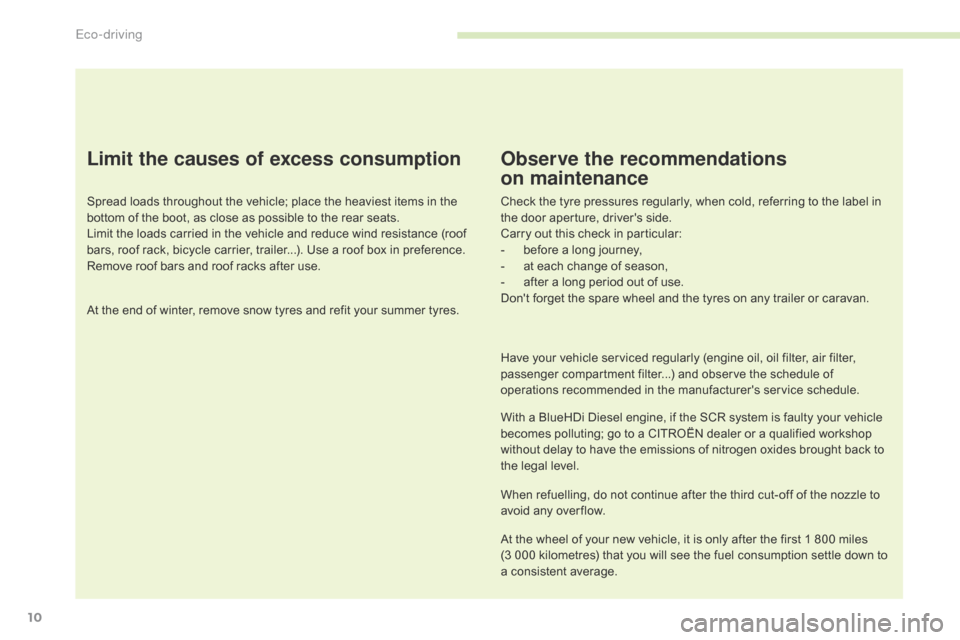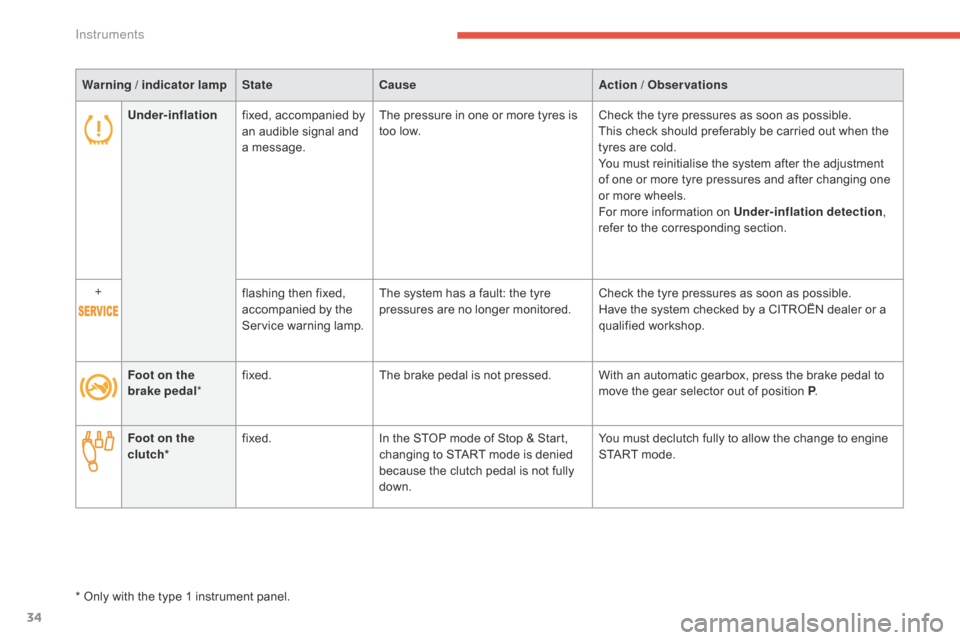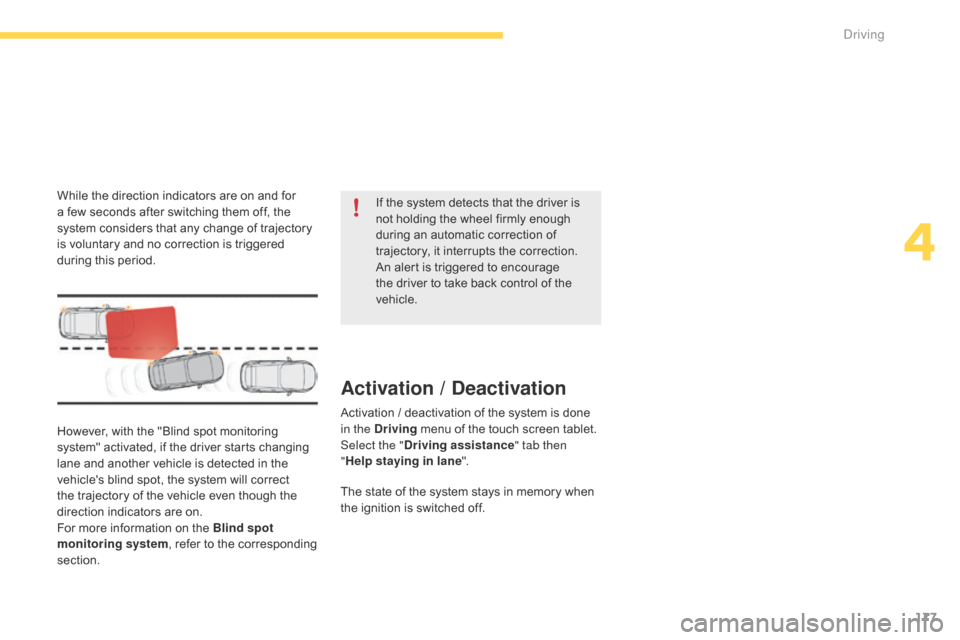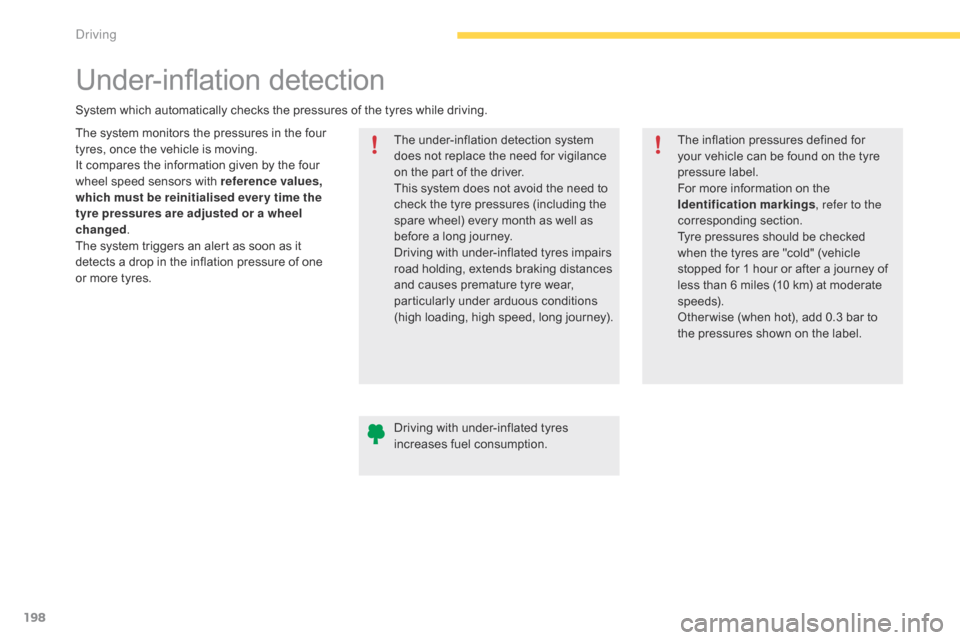change wheel Citroen GRAND C4 PICASSO RHD 2016 2.G Owner's Manual
[x] Cancel search | Manufacturer: CITROEN, Model Year: 2016, Model line: GRAND C4 PICASSO RHD, Model: Citroen GRAND C4 PICASSO RHD 2016 2.GPages: 523, PDF Size: 13.63 MB
Page 12 of 523

10
Limit the causes of excess consumption
Spread loads throughout the vehicle; place the heaviest items in the bottom of the boot, as close as possible to the rear seats.
Limit
the loads carried in the vehicle and reduce wind resistance (roof
b
ars, roof rack, bicycle carrier, trailer...). Use a roof box in preference.
Remove
roof bars and roof racks after use.
At
the end of winter, remove snow tyres and refit your summer tyres.
Observe the recommendations
on maintenance
Check the tyre pressures regularly, when cold, referring to the label in the door aperture, driver's side.
Carry
out this check in particular:
-
b
efore a long journey,
-
a
t each change of season,
-
a
fter a long period out of use.
Don't
forget the spare wheel and the tyres on any trailer or caravan.
Have
your vehicle serviced regularly (engine oil, oil filter, air filter,
p
assenger compartment filter...) and observe the schedule of
o
perations recommended in the manufacturer's service schedule.
With
a BlueHDi Diesel engine, if the SCR system is faulty your vehicle
b
ecomes polluting; go to a CITROËN dealer or a qualified workshop
w
ithout delay to have the emissions of nitrogen oxides brought back to
t
he legal level.
When
refuelling, do not continue after the third cut-off of the nozzle to
a
void any over flow.
At
the wheel of your new vehicle, it is only after the first 1 800 miles
(
3 000 kilometres) that you will see the fuel consumption settle down to
a
consistent average.
Eco-driving
Page 36 of 523

34
Under-inflationfixed, accompanied by a
n audible signal and
a
message. The
pressure in one or more tyres is t
oo low.Check
the tyre pressures as soon as possible.
This check should preferably be carried out when the
t
yres are cold.
You
must reinitialise the system after the adjustment
o
f one or more tyre pressures and after changing one
o
r more wheels.
For
more information on Under-inflation detection,
refer
to the corresponding section.
+ flashing
then fixed,
a
ccompanied by the
S
ervice warning lamp.The
system has a fault: the tyre
p
ressures are no longer monitored.Check
the tyre pressures as soon as possible.
Have
the system checked by a CITROËN dealer or a
q
ualified
w
orkshop.
Warning / indicator lamp
StateCause Action / Observations
Foot on the
brake pedal *fixed.
The
brake pedal is not pressed. With an automatic gearbox, press the brake pedal to
m
ove the gear selector out of position P.
Foot on the
clutch* fixed.
In
the STOP mode of Stop & Start,
c
hanging to START mode is denied
b
ecause the clutch pedal is not fully
d
own.You
must declutch fully to allow the change to engine
S
TART mode.
*
Only
with the type 1 instrument panel.
Instruments
Page 141 of 523

139
+. Control paddle for changing up, to the right o
f the steering wheel.
F
P
ull the " +"
paddle towards you to change up.
-.
C
ontrol paddle for changing down, to the
l
eft of the steering wheel.
F
P
ull the " -"
paddle towards you to change
d
own.
Steering mounted control paddles
The steering mounted control paddles cannot be used to select neutral or to
s
elect or come out of reverse. When
you move the gear selector, the symbol
c
orresponding to its position is displayed in the
in
strument
pan
el.
P.
Pa
rk.
R.
R
everse.
N.
N
eutral.
D.
D
rive
(
automatic
ope
ration).
1 to 6. Gears engaged in manual operation.
-.
I
nvalid value in manual operation.
Displays in the instrument panelMoving off
F With
your foot on the brake pedal, select p
osition P or N .
F
S
tart the engine.
If P
is displayed in the instrument panel,
a
lthough the gear selector is in another
p
osition, place the gear selector in
p
osition P to be able to start the engine.
F
W
ith the engine running, press the brake
ped
al.
F
S
elect automated mode (position D),
manual
mode (position M) or reverse
(position R ).
If
you do not press the
b
rake pedal to come out of
p
osition P,
this warning lamp
I
f these conditions are not met, there
i
s an audible signal accompanied by a
m
essage.
or
symbol appears in the instrument
p
anel, accompanied by the message
"
Place automatic gearbox in position P",
flashing
of P in the instrument panel
a
nd an audible signal.
4
Driving
Page 160 of 523

158
Dynamic cruise control
System that allows, in addition to maintaining your vehicle's speed at a value that you have defined, the inter-vehicle time you have selected between your vehicle and the one in front to be maintained.
Principles of operation
Using a radar with a range of about 100 metres, located at the front of the vehicle, this system
d
etects a vehicle running in front of your
v
ehicle.
It
automatically adapts the speed of the vehicle
t
o that of the vehicle in front.
If
the vehicle in front is running more slowly,
t
he system progressively reduces the speed of
y
our vehicle using just engine braking (as if the
d
river had pressed the "-"
button).
If
your vehicle is too close to or approaching
t
oo quickly the vehicle in front, the dynamic
c
ruise control is automatically deactivated.
T
he driver is then alerted by an audible signal,
a
ccompanied by a message.
Choice of the type of cruise control
The choice between the "dynamic" and "standard" cruise control is done in the Driving
menu.
F
I
n the Driving
menu, select the "Driving
assistance " tab, then "Dynamic cruise
control"
to activate or deactivate the
d
ynamic cruise control.
For
more information on the Cruise
control ,
refer to the corresponding
s
ection.F
P
lace the cruise control
thumbwheel
at "CRUISE". If
the vehicle in front accelerates or changes l
ane, the dynamic cruise control progressively
a
ccelerates your vehicle to return to the
programmed
s
peed.
If
the driver operates a direction indicator
t
o the left (left hand drive) or the right (right
h
and drive), to overtake a slower vehicle, the
d
ynamic cruise control allows your vehicle to
t
emporarily approach the vehicle in front to
a
ssist the overtaking manoeuvre, though never
e
xceeding the programmed speed.
Driving
Page 178 of 523

176
Assisted lane departure warning system
Using a camera placed at the top of the windscreen to identify lane markings on the ground, this systems corrects the trajectory of the vehicle while alerting the driver if it detects a risk of involuntary crossing of a line.
This
system is particularly useful on motor ways and main roads.
The
assisted lane departure warning
s
ystem cannot, in any circumstances,
r
eplace
t
he
n
eed
fo
r
v
igilance
o
n
t
he
par
t
o
f the driver.
The
driver remains responsible for the
v
ehicle in all circumstances. The system
h
elps the driver only when there is a risk
o
f the vehicle involuntarily wandering
f
rom the lane it is being driven on.
I
t does not manage the safe driving
d
istance, the speed of the vehicle or the
b
rakes.
The
driver must hold the steering wheel
i
n a way that allows control to be taken
b
ack in circumstances where the system
i
s not able to intervene (where there are
no
lane markings, for example).
It
is necessary to observe the driving
r
egulations and take a break every
t
wo hours.
Operation
Conditions for operation
The speed of the vehicle must be between 40 a
nd 112 mph (65 and 180 km/h).
The
carriageway must have at least one lane
m
arking (solid or broken) on the ground.
The
driver must hold the wheel with both
han
ds.
The
change of trajectory is not accompanied by
o
peration of the direction indicators.
The
ESC system must be activated. Once
the system identifies a risk of the vehicle i
nvoluntarily crossing one of the lane markings
d
etected, it makes the correction to the
t
rajectory necessary to return the vehicle to its
in
itial
pa
th.
The
driver will then notice a turning movement
o
f the steering wheel.
This
warning lamp flashes during
t
rajectory
c
orrection.
If
the driver wishes to maintain the
t
rajectory of the vehicle, they can
p
revent the correction by keeping a firm
g
rip on the wheel (during an avoiding
m
anoeuvre, for example).
The
correction is interrupted if the
d
irection indicators are operated.
Driving
Page 179 of 523

177
However, with the "Blind spot monitoring system" activated, if the driver starts changing
l
ane and another vehicle is detected in the
v
ehicle's blind spot, the system will correct
t
he trajectory of the vehicle even though the
d
irection indicators are on.
For
more information on the Blind spot
monitoring system ,
refer to the corresponding
s
ection. If
the system detects that the driver is
n
ot holding the wheel firmly enough
d
uring an automatic correction of
t
rajectory, it interrupts the correction.
A
n alert is triggered to encourage
t
he driver to take back control of the
v
ehicle.
Activation / Deactivation
Activation / deactivation of the system is done i
n the Driving menu of the touch screen tablet.
Select the " Driving assistance " tab then
" Help staying in lane ".
The
state of the system stays in memory when
t
he ignition is switched off.
While
the
direction
indicators
are
on
and
for
a
few
seconds
after
switching
them
off,
the
s
ystem
considers
that
any
change
of
trajectory
i
s
voluntary
and
no
correction
is
triggered
d
uring
this
period.
4
Driving
Page 192 of 523

190
Park Assist
This system provides active assistance with parking. It detects a parking space then
o
perates the steering to park in the space.
It
operates the steering while the driver
m
anages the accelerator, brakes, gears and
c
lutch (manual gearbox). During phases of
e
ntry into and exit from a parking space, the
s
ystem provides visual and audible information
t
o the driver in order to make the manoeuvres
s
afe. It may be necessary to move for wards
a
nd backwards more than once. During
a manoeuvre the steering
w
heel turns quickly: do not hold the
s
teering wheel, do not place your hands
b
etween the spokes of the steering
w
heel and take care with loose and
b
ulky clothing, scarves, handbags...
T
here is a risk of injury.
When
Park Assist is activated, it
p
revents a change to STOP mode of
S
top & Start. In STOP mode, activation
o
f Park Assist restarts the engine.
The
Park Assist system cannot in any
c
ircumstances replace the need for
v
igilance on the part of the driver.
The
driver must remain in control
o
f their vehicle ensuring that the
s
pace remains clear throughout the
m
anoeuvre.
In
some circumstances, the sensors
m
ay not detect small obstacles located
i
n their blind spots.
The
driver can take control at any time by
g
ripping the steering wheel. The
Park Assist system provides assistance for t
he following manoeuvres:
A.
E
ntry into a parallel parking space
B.
E
xit from a parallel parking space
C.
B
ay
par
kingThe
Park Assist system takes control
o
f the power steering for a maximum
o
f 4 manoeuvre cycles. The function
i
s deactivated after these 4 cycles.
I
f you think that your vehicle is not
p
ositioned correctly, you should then
t
ake control of the steering to carry out
t
he manoeuvre.
The
Park Assist system cannot work
w
ith the engine off.
Driving
Page 200 of 523

198
Under-inflation detection
The system monitors the pressures in the four t
yres, once the vehicle is moving.
It
compares the information given by the four
w
heel speed sensors with reference values,
which must be reinitialised ever y time the
tyre pressures are adjusted or a wheel
changed .
The
system triggers an alert as soon as it
d
etects a drop in the inflation pressure of one
o
r more tyres. The
under-inflation detection system
d
oes not replace the need for vigilance
o
n the part of the driver.
This
system does not avoid the need to
c
heck the tyre pressures (including the
s
pare wheel) every month as well as
b
efore a long journey.
Driving
with under-inflated tyres impairs
r
oad holding, extends braking distances
a
nd causes premature tyre wear,
p
articularly under arduous conditions
(
high loading, high speed, long journey).
System
which automatically checks the pressures of the tyres while driving.
The inflation pressures defined for
y
our vehicle can be found on the tyre
p
ressure label.
For
more information on the
I
dentification markings, refer to the
corresponding
s
ection.
Tyre
pressures should be checked
w
hen the tyres are "cold" (vehicle
s
topped for 1 hour or after a journey of
l
ess than 6 miles (10 km) at moderate
s
peeds).
Other wise
(when hot), add 0.3 bar to
t
he pressures shown on the label.
Driving
with under-inflated tyres
i
ncreases fuel consumption.
Driving
Page 227 of 523

225
Anti-slip regulation (ASR)
Activation
This system is activated automatically each time the vehicle is started.
It
comes into operation in the event of a
p
roblem of grip.
Deactivation
In exceptional conditions (starting a vehicle which is bogged down, stuck in snow, on soft
g
round...), it may be advisable to deactivate
t
he DSC and ASR, so that the wheels can turn
f
reely and regain grip.
This
is
indicated
by
the
flashing
of
t
his
warning
lamp
in
the
instrument
pan
el. Reactivate
the systems as soon as the level of
g
rip permits.
F
I
n the Driving
menu, select the "Driving
assistance " tab, then "Anti-slip
regulation ".
This
indicator lamp comes on in the
in
strument
pan
el.
The
ASR system will no longer act
o
n the operation of the engine and
o
n the brakes in the event of an
i
nvoluntary change of trajectory.
After
an
impact,
have
the
system
checked
by
a
C
ITROËN
dealer
or
a
qualified
workshop.
Operating fault
Reactivation
The system is reactivated automatically every t
ime the ignition is switched back on or from 30
m
ph (50 km/h).
Below
30 mph (50 km/h), you can reactivate it
m
anually:
F
I
n the Driving
menu, select the "Driving
assistance " tab, then "Anti-slip
regulation ".
Illumination
of this warning lamp,
a
ccompanied by an audible signal
a
nd a message, indicate a fault with
t
he system.
Contact
a CITROËN dealer or a qualified
w
orkshop to have the system checked.
6
Safety
Page 297 of 523

295
Removing a wheel
Parking the vehicle
Immobilise the vehicle where it does not block traffic: the ground must be level,
s
table and not slippery.
Apply
the parking brake unless it has
b
een programmed to automatic mode,
s
witch off the ignition and engage first
g
ear* to block the wheels.
Check
that the braking warning lamp
a
nd the P warning lamp in the parking
b
rake control lever come on.
For
greater safety, place the chock 2
against
the wheel opposite to the one
b
eing
c
hanged.
The
occupants must get out of the
v
ehicle and wait where they are safe.
Never
go underneath a vehicle
s
upported by a jack; use an axle stand.
List of operations
F Remove the wheel bolt cover(s) using the t
ool 4 (depending on equipment).
F
F
it the security socket 5 on the
wheelbrace
1 to slacken the security bolt
(
if fitted).
F
S
lacken the other bolts (no more than a
1
/4 turn) using the wheelbrace 1
o
n l y.
* Position P
for
an
automatic
gearbox. Do
not use:
-
t
he jack for any purpose other than
l
ifting the vehicle,
-
a
ny other jack than the one
s
upplied by the manufacturer.F
P
lace the foot of the jack 3 on the ground
a
nd check that it is directly below the
f
ront A or rear B jacking point provided on
t
he underbody, whichever is closest to the w
heel to be changed.
Ensure that the jack is stable. If the
g
round is slippery or loose, the jack
m
ay slip or drop - Risk of injury!
Ensure
that the jack is positioned only
a
t one of the jacking points A or B
under
the vehicle, making sure that the
v
ehicle's contact sur face is centred on
t
he head of the jack. Other wise there is
a
risk of damage to the vehicle and/or of
t
he jack dropping - Risk of injury!
8
In the event of a breakdown